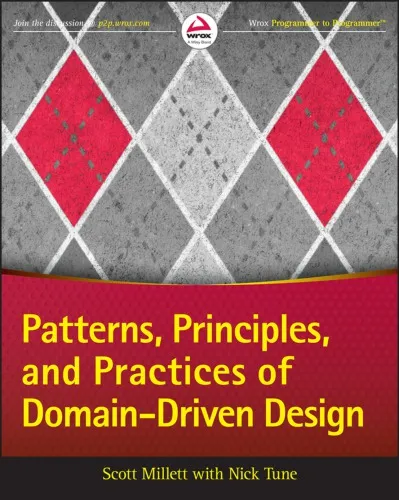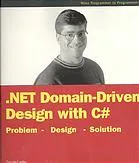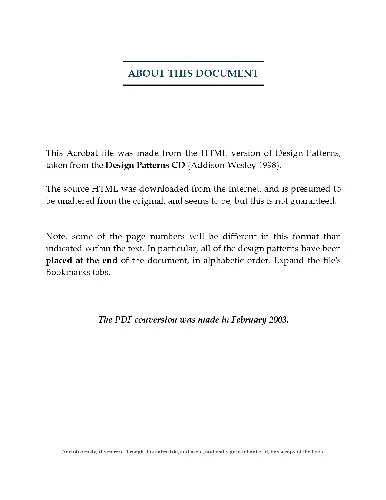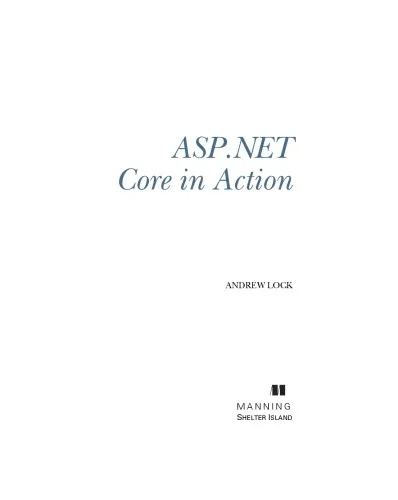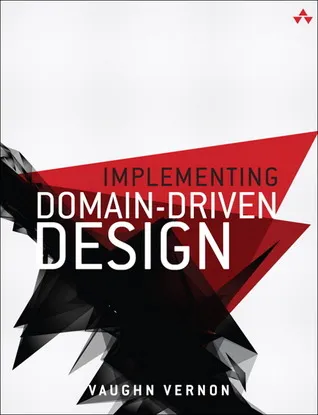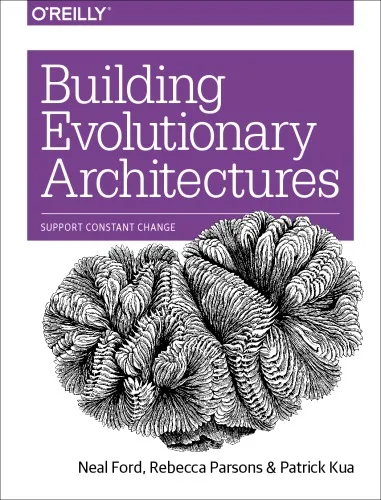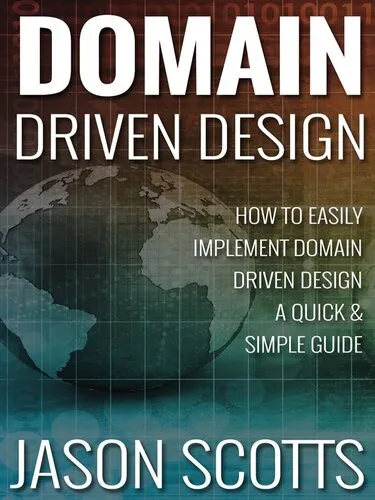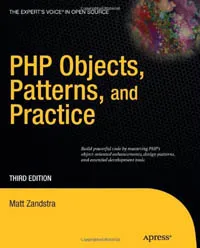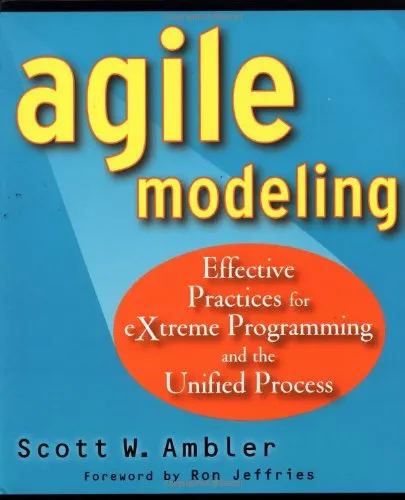Patterns, Principles and Practices of Domain-Driven Design
4.7
بر اساس نظر کاربران

شما میتونید سوالاتتون در باره کتاب رو از هوش مصنوعیش بعد از ورود بپرسید
هر دانلود یا پرسش از هوش مصنوعی 2 امتیاز لازم دارد، برای بدست آوردن امتیاز رایگان، به صفحه ی راهنمای امتیازات سر بزنید و یک سری کار ارزشمند انجام بدینRelated Refrences:
Persian Summary
مقدمهای بر کتاب "Patterns, Principles and Practices of Domain-Driven Design"
کتاب "Patterns, Principles and Practices of Domain-Driven Design" تلاشی ارزشمند است برای ترکیب کردن اصول حرفه ای توسعه نرمافزار با تکنیکهای پیشرفته طراحی. این کتاب توسط اسکات ملت و نیک تون به نگارش درآمده و مورد توجه گستردهای قرار گرفته است.
خلاصهای تفصیلی از کتاب
این کتاب به طور جامع به مبحث Domain-Driven Design (DDD) میپردازد و ابزار و تکنیکهایی را برای طراحی نرمافزار پیچیده به توسعهدهندگان ارائه میدهد. با تمرکز بر پویایی و تعاملات دنیای واقعی، نویسندگان تلاش کردهاند که به خوانندگان کمک کنند تا چگونگی مدلسازی دامنههای پیچیده را به نحو بهینهتری بیاموزند.
کتاب در درجه نخست به مفاهیمی همچون Bounded Context، Ubiquitous Language، و Aggregate میپردازد، سپس تکنیکهای کاربردی برای پیادهسازی این مفاهیم در پروژههای واقعی ارائه میدهد. این اثر همچنین مثالهای کد و الگوهای طراحی مختلفی را برای بهتر فهمیدن مفاهیم تئوریک به کار میبرد.
یافتههای کلیدی
- درک عمیق اصول DDD: تاکید بر اهمیت درک زبان مشترک و استفاده از Ubiquitous Language در میان تیمها.
- کاربرد عملی الگوها: ارائه مثال و نمونهکدهایی برای فهم بهتر نحوه کار الگوهای طراحی.
- تمرکز بر دامنه: راهکارهای عملی برای تمرکز بر دامنههای پیچیده در پروژههای بزرگ.
- ارتقای ارتباط تیمی: استفاده از مدلهای مفهومی برای بهبود ارتباطات و هماهنگی بین اعضای تیم.
جملات معروف از کتاب
"در طراحی نرمافزار، اهمیت زبان مشترک چیزی کمتر از اهمیت فناوریهای مورد استفاده نیست."
"Domain-Driven Design یک شیوه زندگی است که شما را قادر میسازد تا نرمافزارهایی بسازید که واقعاً نیازهای کسب و کار را منعکس میکند."
چرا این کتاب اهمیت دارد
کتاب "Patterns, Principles and Practices of Domain-Driven Design" یک راهنمای جامع است که نه تنها به توسعهدهندگان حرفهای، بلکه به کل افراد دخیل در پروژههای نرمافزاری کمک میکند تا دیدگاه جدیدی نسبت به فرآیند توسعه داشته باشند. این کتاب با ارائه روشهای عملی برای بهبود طراحی سیستم، به افزایش کیفیت و کارایی توسعه نرمافزار کمک کرده و به عنوان یکی از منابع اصلی در حوزه DDD شناخته میشود.
همچنین، از آنجا که بسیاری از پروژههای بزرگ با مشکلات پیچیدهای در دامنههای گسترده سر و کار دارند، این کتاب مجموعهای از ابزارهای ارزشمند را برای رهبری و مدیریت چنین پروژههایی فراهم میکند. به همین دلیل، این اثر همچنان به عنوان یک منبع اساسی و کلیدی در دنیای طراحی نرمافزار به شمار میآید.
Patterns Principles and Practices of Domain-Driven Design
A Comprehensive Guide to Domain-Driven Design
Detailed Summary of the Book
Patterns Principles and Practices of Domain-Driven Design is a comprehensive guide to Domain-Driven Design DDD a software development approach that focuses on understanding the core business domain and modeling it in code. Written by Scott Millett and Nick Tune the book provides a thorough introduction to the principles patterns and practices of DDD making it an essential resource for software developers architects and domain experts.
The book begins by introducing the fundamentals of DDD including the importance of understanding the business domain the role of the domain model and the concept of bounded contexts. It then delves into the principles of DDD such as the need for a shared language the importance of continuous learning and the role of feedback in the development process.
The authors also explore the various patterns and practices of DDD including entity value object and aggregate patterns as well as the use of repositories factories and domain events. They provide detailed examples and case studies to illustrate the application of these patterns and practices in real-world scenarios.
In addition to the technical aspects of DDD the book also covers the social and cultural aspects of software development including the importance of collaboration communication and continuous improvement. The authors emphasize the need for a shared understanding of the business domain and the importance of involving domain experts in the development process.
Key Takeaways
Some of the key takeaways from the book include
- Understanding the business domain is crucial to developing effective software solutions.
- A shared language and shared understanding of the business domain are essential for successful software development.
- Continuous learning and feedback are critical components of the DDD approach.
- Patterns and practices such as entity value object and aggregate patterns can help to simplify complex business domains.
- Collaboration and communication between developers domain experts and stakeholders are essential for successful software development.
Famous Quotes from the Book
Some notable quotes from the book include
"The domain model is not just a technical artifact but a shared understanding of the business domain that is used to guide the development of the software."
"The goal of DDD is not to create a perfect model of the business domain but to create a model that is good enough to support the development of effective software solutions."
"The use of patterns and practices such as entity value object and aggregate patterns can help to simplify complex business domains but they should not be used as a substitute for a deep understanding of the business domain."
Why This Book Matters
Patterns Principles and Practices of Domain-Driven Design is an essential resource for software developers architects and domain experts who want to improve their understanding of the business domain and develop more effective software solutions. The book provides a comprehensive introduction to the principles patterns and practices of DDD making it an ideal resource for those who are new to the subject.
The book also provides a wealth of practical advice and real-world examples making it a valuable resource for experienced developers who want to improve their skills and knowledge of DDD. The authors' emphasis on the social and cultural aspects of software development also makes the book a valuable resource for those who want to improve their collaboration and communication skills.
Overall Patterns Principles and Practices of Domain-Driven Design is a must-read for anyone who wants to develop a deeper understanding of the business domain and improve their software development skills.
دانلود رایگان مستقیم
شما میتونید سوالاتتون در باره کتاب رو از هوش مصنوعیش بعد از ورود بپرسید
دسترسی به کتابها از طریق پلتفرمهای قانونی و کتابخانههای عمومی نه تنها از حقوق نویسندگان و ناشران حمایت میکند، بلکه به پایداری فرهنگ کتابخوانی نیز کمک میرساند. پیش از دانلود، لحظهای به بررسی این گزینهها فکر کنید.
این کتاب رو در پلتفرم های دیگه ببینید
WorldCat به شما کمک میکنه تا کتاب ها رو در کتابخانه های سراسر دنیا پیدا کنید
امتیازها، نظرات تخصصی و صحبت ها درباره کتاب را در Goodreads ببینید
کتابهای کمیاب یا دست دوم را در AbeBooks پیدا کنید و بخرید
سوالات پرسیده شده از این کتاب
2632
بازدید4.7
امتیاز0
نظر98%
رضایتنظرات:
4.7
بر اساس 0 نظر کاربران
Questions & Answers
Ask questions about this book or help others by answering
No questions yet. Be the first to ask!
